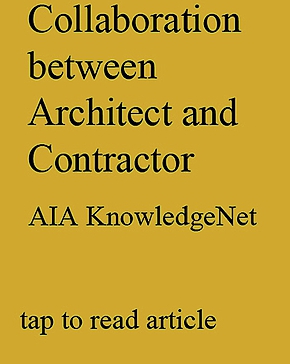Errors and Omissions and Standard of Care
By Paul Potts
Owners who are experienced with design and construction understand that the architect’s drawings and specifications will include some mistakes. The AIA B101 Owner-Architect Agreement states that:
“§ 2.2 The Architect shall perform its services consistent with the professional skill and care ordinarily provided by architects practicing in the same or similar locality under the same or similar circumstances. The Architect shall perform its services as expeditiously as is consistent with such professional skill and care and the orderly progress of the Project.”
This is referred to as the “standard of care”. There is no attempt to define when the accumulation of mistakes or a single error would breach the standard of care, that would be decided by the trier of fact (arbiter, judge or jury) if litigation were to occur. But, the concept of standard of care, which makes allowances for mistakes, is well understood by experienced owners.
While projects designed by sophisticated architectural firms, constructed by equally sophisticated contractors with experienced owners have have the best ingredients for cooperation when complications develop, what about inexperienced owners, who are rarely involved in design and construction? During contract negotiations the architect should discuss the subject of document mistakes—that is, errors and omissions, with them. Such early discussions will help preserve a constructive relationship when mistakes are encountered during the project. Mistakes fall into at least three categories.
Omissions
It’s important to know the difference between an error and an omission when discussing these change orders with the client. An omission occurs, for example, when an egress sidewalk, required by code, is not shown on the drawings. Once the missing sidewalk is cited by the code official the contractor will be issued a change order to install the sidewalk. The owner has not paid for the sidewalk at bid time and for this reason, the architect can refer to it as a “betterment” or value added change order.
Design Errors
A design error, on the other hand, is a mistake in the plans and specifications that requires replacement of already-built construction or equipment, with the original materials most likely being thrown away.
For example, the architect did not schedule a fire rated ceiling assembly in the music room of a high school auditorium where the space above ceiling was used as a return air plenum. This is a violation of the Life Safety Code®: According to NFPA 101® the ceiling should have been a fire rated assembly. The mistake was cited by the fire marshal and the contractor was given a change order to remove and reinstall the rated ceiling. In the case the owner will pay twice for the same ceiling. It’s obvious from these illustrations why it is easier to discuss an omission with the owner as opposed to an error.
Code Compliance Errors and Omissions
Code compliance errors and omissions are a separate category. Code compliance inspectors have great latitude to interpret the code, even after the plans and specifications have been reviewed and approved for construction. The law is quite clear that plan review and stamping construction documents “Approved” does not warrant the documents are free of code oversights that must be corrected if cited by the inspector.
It increases construction costs considerably to try to anticipate everything that a code official might cite as a violation. For example, the life safety code is quite clear that fire alarm pull stations should be placed at all egress exits; but some compliance inspectors require a pull station in the path of egress including corridors not just at the egress doors. One must incorporate the code to the best of one’s ability and accept that inspectors will could find some loose ends. But the cost of these corrections should not be lumped together with other types of errors and omissions when assessing the architect’s performance.
Regardless if it’s an error or an omission, mistakes in the construction documents can lead to friction with the owner. The best strategy to avoid confrontation over mistakes in the drawings is to have an upfront discussion with the owner about the standard of care before the contract is signed.
What Is Professional Standard of Care
Professional standard of care, founded in common law, attempts to define a minimum level required of architects and other professionals in the performance of their duties under the contract and professional responsibilities.
Common law is a body of case law adopted by each of the U.S. colonies at the time of the Declaration of Independence (1776). The colonies each adopted English common law because it was easier to adopt an already complete body of law rather than starting from scratch. Common law has evolved over the years by precedent established in subsequent cases state by state. While common law is unique to each state, there is consistency across the United States as each state adopts important precedence established in other state jurisdictions.
The earliest recorded judicial definition of standard of care was provided by Mr. Chief Justice Peters in the case of Beede vs. Coombs, in 1896 in the State of Maine Supreme Court. An architect hired another architect to design a home and barn for he and his wife. The cost exceeded the estimate and the owner sued the architect for negligence. Finding in favor of the architect, the court wrote:
“The undertaking of an architect implies that he possesses skill and ability, including taste, sufficient to enable him to perform the required services at least ordinarily and reasonably well; and that he will exercise and apply in the given case his skill and ability, his judgment and taste, reasonably and without neglect. But the undertaking does not imply or warrant a satisfactory result. It will be enough that any failure shall not be by the fault of the architect. There is no implied promise that miscalculations may not occur. An error in judgment is not necessarily evidence of a want of skill or care, for mistakes and miscalculations are incident to all the business of life.”
Negotiations with the Claiming Contractor
Contractors have considerable leverage in negotiating the price for change orders. Principally because they are already mobilized on the site and it would be difficult to bring in competitively priced outside contractor to do the work. For this reason, the owner, architect and construction manger are stuck negotiating the price with the contractor they have even if there is disagreement over the price.
If the contractor simply refuses to reduce the price, there are few alternatives other than continuing to negotiate. The problem is: prices for materials are easily confirmed, but the hours required to do the work is not easily disproven. There are terms in Article 7 of the AIA general conditions that direct the contractor to proceed with the work if disagreements over the terms of a change order or change directive become intractable. Under these terms the contractor would be working on a time and material basis.
The construction manager has more power and leverage to stare down the contractor in these confrontations than the owner or the architect, if they are willing to use it. They also have staff that can take off material and labor to provide comparison pricing. As a last resort, the owner can issue a construction change directive and have the contractor do the work on a time and material basis.
Design-Build
Many in the construction industry believe that the design-build project delivery method reduces the incidence of errors and omissions change orders and there is some data supporting this view. During the Professional Liability Insurance Carrier Annual Interviews – 2016 sponsored by the American Institute of Architects, insurance carriers somewhat confirmed this, but the summary of the conference had this to say about design-build risk:
“Many carriers continue to note that while claims frequency appears to be reduced in Design-Build, claims severity appears to be higher than in traditional Design-Bid-Build. Some carriers suggested that this (reduction in claims) is the result of the more collaborative nature of Design-Build, which allows for early constructive claim resolution. Nevertheless, when claims occur on a Design-Build project, design-builders are very motivated and able claimants against design professionals.”:
Reviewing Change Orders with the Owner
The architect should inform the owner when becoming aware of an error or omission. Before meeting with the owner to discuss the matter, the architect should become thoroughly acquainted with the facts of the mistake and what the probable consequences are to fix it. Knowledge and honesty will impress most owners.
Errors and Omissions and the Contingency Budget
Every responsible construction budget has a line item for contingencies, from 5 to 10-percent of the construction cost. The contingency provides for unexpected developments including errors and omissions, but a specific amount for mistakes is rarely broken out. How much contingency money should be set aside for errors and omissions will depend on the whether the project is new construction or renovation, and on the project’s complexity (e.g., complicated hospital or simple build-out of office
space). It also depends on the method of delivering the project (e.g., design-bid-build or design-build) or whether the project is fast-tracked. No single percentage of errors and omissions applies to all projects. AIA B103 (2017) Standard Form of Agreement Between Owner and Architect for a Complex Project has a variety of terms that address the contingencies associated with fast-track projects.
Conclusion
While it may be difficcult for the architect to bring up the matter of mistakes in the documennts, especially after months of pursuing the owner to get the project in the firsts place. The strategic time to discuss standard of care, and to make sure the owner understands what it means, is during contract negotiations. The owner has already gone to considerable lengths to engage the architect and it is unlikely they will break off negotiations over a realistic discussion about errors and omissions. Having this discussion before the owner-architect contract is inked is much more likely to have a positive outcome than waiting until the first E&O change order needs to be signed.






